|
|
|
»
Deutsche Fassung: hier
klicken! |
Kyosho
Inferno ST US Sports
Part
#2: RTR-equipment and accessories
|
|
|
|
|
RTR
= Ready to Run |
|
|
|
Ready to Run
has to be taken with a grain of salt: For obvious reasons there
is no fuel supplied (Kyosho Germany recommends Morgan Fuels
Sidewinder 25%) and neither are the batteries. RTRs also differ
from kit models by extra built-in R/C equipment, engine and GP
accessories. With the
Inferno ST-S US Sports Kyosho includes the following:
-
Engine: Kyoshos'
engine series in big block-size: The GXR-28 has got 4,6ccm and
is equipped with a pullstart.
-
Radio-system:
The radio control is a (27 MHz AM) computer system built by Sanwa, according to Kyosho. A 'Perfex' mini receiver is
preassembled into the truggy next to the servos.
-
Accessories:
Kyosho hooks you up with the obligatory tools plus a glow plug
heater and a fuel bottle. (250ccm)
All hyperlinks marked
like this
will be opened in a new browser window!
|
|
|
GXR-28 take one: big block
power bite-sized. |
|
|
|
It has become en vogue to
equip RTR truggies with big block engines. These are
engines the size of a .21 engine but they actually have
a displacement of 4.1 to 5.2ccm.
This makes it possible to produce low-cost engines that
are still relatively poweful given their greater
cylinder capacity. In the .21 class this would only be
possible at much higher costs. |
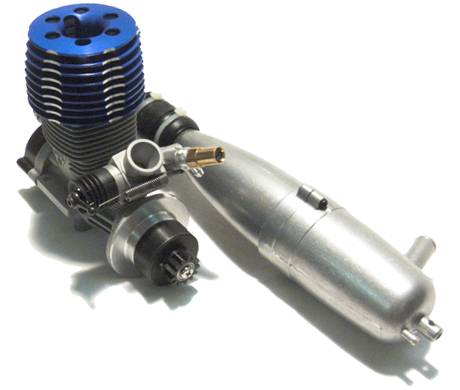 |
Kyosho makes no
exception here and powers the Inferno ST-S with a 4.6ccm
engine.
Typically for Kyoshos' engine series is the bolted
exhaust manifold (which is normally held in place by a
sturdy spring) as well as the direct attachment
to the chassis via four M3 screws. |
|
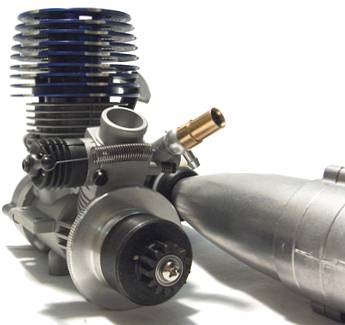 |
Surely one can argue about
the pros and cons of this type of mounting. But it's a
fact that Kyosho spared themselves the usually necessary
motor mounts that have to be acquired seperately in
order to use other engines.
The carburetor of the GXR-28
features two controls (main needle and idle needle)
and a throttle stop screw.
Laudably Kyosho is pretty keen on safety and therefore a
tension spring that closes the carburetor automatically
is attached to the slide valve.
The spring keeps the car (and its surroundings) from
greater damage in case that a linkage loosens itself and
the servo is no longer connected to the carburetor.
Unlike the 'mechanical fail save' in Jamaras' 'Track
Sau' the spring is not strong enough to close the
carburetor plus a dead servo. |
A really intriguing
construction can be found at the rear side of the engine:
The pull start that Kyosho thought up here is pretty
much the only 'onboard' starting mechanism that could
come close to a starterbox... Why is that?
- The pull start
does not use a one-way bearing (a well known wear and
tear part with pull starts)
- As soon as the
engine is running the whole starting mechanism is
completely decoupled so that sealing the
backplate becomes an easier job.
The ingenious thing
about it is that Kyoshos system is no more
complicated than conventional pull starts, but let's see
what goes on behind (or rather inside) it! |
The picture on the
right shows the components of the starting mechanism: The
starter shaft looks similar to the ones of other
pullstarts - apart from a bore hole at its end...
The notch in the disc allows the starter shaft to 'hook'
into the pivot.
The thing right next to it is the most important part of
Kyoshos' starting system: The slotted steel bushing in
connection with an actuating pin replaces the ordinary
one-way bearing.
In order for the system to
work the starter shaft has to be able to move in axial
direction. (picture 1 below) |
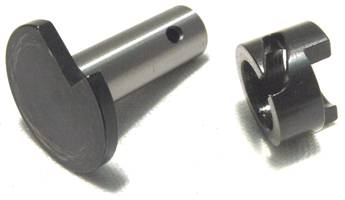 |
|
 |
- The rope drum
engages with the actuator bushing and rotates
clockwise when starting (see picture 2) The
actuating pin glides along the slot and pushes the
starter shaft against the pivot and engages the
crankshaft. A form locking
connection is only established when the actuating
pin reaches the end of its slot (like in picture 2)
and the starting disc hooks onto the pivot.
Depending on the position of both points of
engagement up to 10 centimetres of rope are needed
until the engine is turned - but decently then,
because the system uses no wearing parts.
- When the spring is
winding up the rope like in picture 3 (or the engine
is running faster than the pullstart!) the actuating
pin again rides along its slot to the end point and
pulls away the starter disc from the pivot.
Pullstart and engine are now completely decoupled
from each other until the next starting procedure.
From a mechanical point
of view, the system could still be improved: no shims are used
between the cast aluminum case and the starter bushing/shaft
that could take axial forces and prevent abrasion. But
it remains to be seen whether such shims are really
necessary.
In any case Kyosho performed a masterstroke with this
pull start! |
Inside
the crankcase, it's somewhat less spectacular.
The inner surfaces are not polished, the bottom bushing of
the piston rod (which has a bit more play right from the
start than most other engines) is drilled triply for better lubrication but the
shape has not been optimized. The piston runs in a
three-channel cylinder liner where I had to find some
swarf from machining. The 14 millimetre
crankshaft has a 'Standard' end. This means that the
clutch bell needs an additional flywheel adaptor.
The clutch seems to fit the engine
well: The two-piece clutch
is completely released at idle speed and engages
adequately: It neither exerts the engine nor is there a
need for unnecessary high RPM to get the power down to
the wheels.
The tuned pipe is a
'real' two chamber type with a surprisingly high amount
of damping without taking engine power. (8 millimetres
exhaust, 12 millimetres of cone opening, pressure fitting
in the second chamber) |
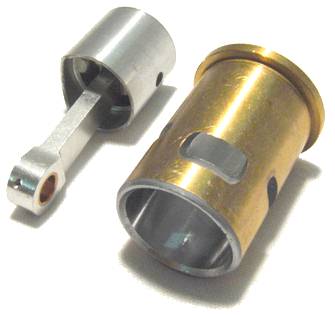 |
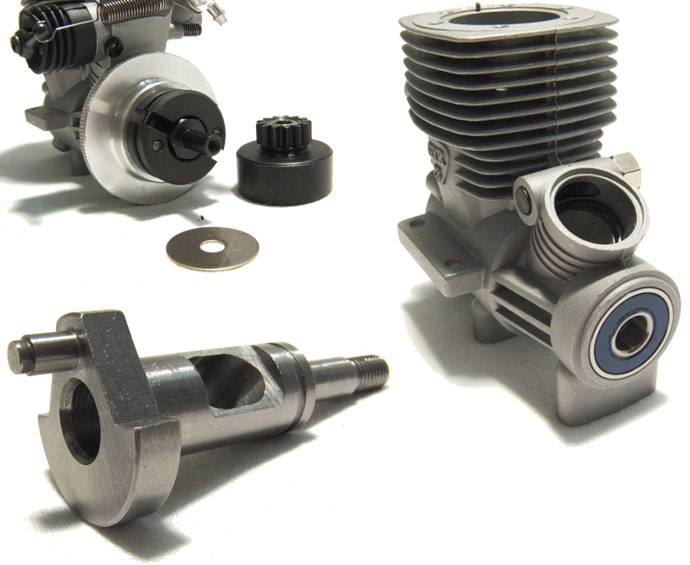 |
|
|
|
Perfex
RC-system |
|
|
|
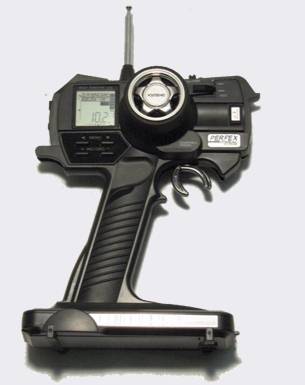 |
One of the obvious
accessory-upgrades against the 'standard Sports' is the radio unit.
You get a computer system with twelve model memory slots and all the
goodies like end point adjustment for throttle/brake and steering,
expo and sub trim. Self evidently with those features you will also
find basic functions like servo reverse and a steering throw limit.
Menu-wise some manufacturers could
take a leaf out of Kyosho's book:
The whole radio gets by on just four buttons. Using the menu keys
you scroll the parameters which then start to blink on the big,
well-readable display. Setting is done by pressing '+/-' and then
it's the menu key again: simple and effective!
There are additional rocker switches on the top side for trimming
both channels and adjusting the steering throw without having to use
the menu. The display shows trim positions, model memory and a
battery indicator. Power is supplied by eight AA cells and - looking
at other RTRs it's not too trivial to mention the fact that this
transmitter is also featuring a charging jack. |
|
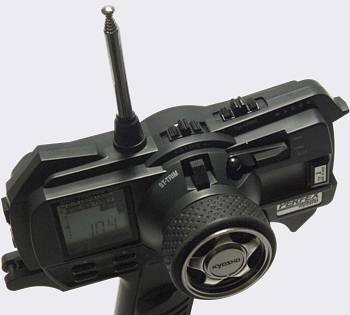 |
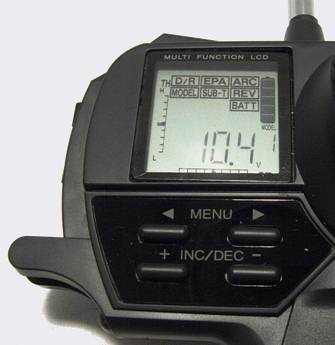 |
|
|
Top right to the wheel you can see a
swich for an additional channel which is neither used with the
Inferno ST nor supported by the mini-receiver. (35x25x16 mm)
The Perfex-transmitter can surely be counted to the RTR-premium
class. It is only surpassed by very few kits with FM system. But those come in at a totally different
price level.
|
Up to now the
RTR-equipment made quite a decent impression but now,
it's time for what I called a 'lack of consequency' in
the first part of the review:
Right at the end Kyosho lives up to the RTR-cliché and
throws at us some plastic geared and busehd servos with
a nominal force of 5kg*cm and a retention force of
8kg*cm (80% throw, 5° deviation) at 6 volts.
Not even the loosened servo saver is able to conceal it
- quite the contrary: Due to the twenty degrees of
caster at the front, especially the high speed
performance is afflicted.
A real pity - looking at
the auspicious start of it all. And incomprehensible -
given the fact that this is a truggy. |
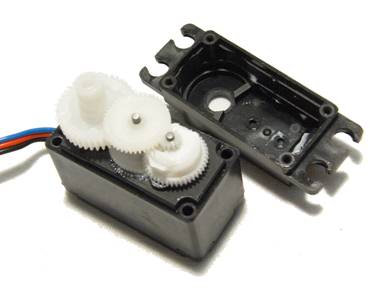 |
|
The additional costs
for servos that match the other RTR-components would
have been bearable due to the added value. |
|
|
|
"Me
glow you long time ..." |
|
|
|
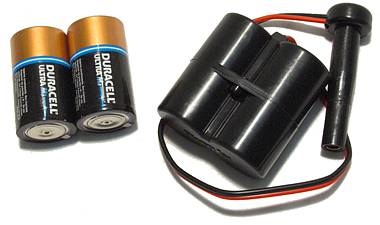 |
Next to a
fuel bottle, some Allen keys and a four-way socket
wrench Kyosho also supplies an unconventional but
interesting glow plug heater: The housing fits two fat
D-cell batteries connected in parallel which allows for
capacities up to 30Ah - more than three times of a
conventional 2V lead battery and nearly ten times of a
sub-C glower.
With rechargeable batteries it's still up to 18Ah -
they only have to be taken out in order to be recharged
because the heater is only pressed onto the glow plug
and will not hold to a charging plug by itself. |
|
|
|
Checkpoint! |
|
|
|
Interim results - take two.
It's just like the feature-thing again - just not as harsh: A
simple engine with a revolutionary pull start , great radio ... and
servos that are no more than an also-ran.
Again you get the
impression that Kyoshos way was paved with good intentions - but
somewhere along they got more off-road than they should have. Would
have been better to get a map - meaning to raise the retail
price in order to afford better servos.
Indeed the Inferno ST-S
US Sports does have a very decent RTR equipment (compared to other
RTRs) Due to the servos (like in lots of other cars) its suitability
is somewhat limited: Even the beginner should at least exchange the
steering servo for a truggy-adequate one. In our case it will be the
Thunder Tiger/Ace RC DS1015 for roundabout € 85.
|
|
Text and photography by
Aaron Banovics,
translation by Markus Simon
This article has been published on
www.offroad-cult.org
on 20.12.2006.
|

|